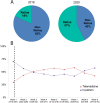Modeling the impact of COVID-19 on Retina Clinic Performance
- PMID: 33971832
- PMCID: PMC8107774
- DOI: 10.1186/s12886-021-01955-x
Modeling the impact of COVID-19 on Retina Clinic Performance
Abstract
Background: COVID-19, a highly contagious respiratory virus, presents unique challenges to ophthalmology practice as a high-volume, office-based specialty. In response to the COVID-19 pandemic, many operational changes were adopted in our ophthalmology clinic to enhance patient and provider safety while maintaining necessary clinical operations. The aim of this study was to evaluate how measures adopted during the pandemic period affected retina clinic performance and patient satisfaction, and to model future clinic flow to predict operational performance under conditions of increasing patient and provider volumes.
Methods: Clinic event timestamps and demographics were extracted from the electronic medical records of in-person retina encounters from March 15 to May 15, 2020 and compared with the same period in 2019 to assess patient flow through the clinical encounter. Patient satisfaction was evaluated by Press Ganey patient experience surveys obtained from randomly selected outpatient encounters. A discrete-events simulation was designed to model the clinic with COVID-era restrictions to assess operational performance under conditions of increasing patient and provider volumes.
Results: Retina clinic volume declined by 62 % during the COVID-19 health emergency. Average check-in-to-technician time declined 79 %, total visit length declined by 46 %, and time in the provider phase of care declined 53 %. Patient satisfaction regarding access nearly doubled during the COVID-period compared with the prior year (p < 0.0001), while satisfaction with overall care and safety remained high during both periods. A model incorporating COVID-related changes demonstrated that wait time before rooming reached levels similar to the pre-COVID era by 30 patients-per-provider in a 1-provider model and 25 patients-per-provider in a 2-provider model (p < 0.001). Capacity to maintain distancing between patients was exceeded only in the two 2-provider model above 25 patients-per-provider.
Conclusions: Clinic throughput was optimized in response to the COVID-19 health emergency. Modeling these clinic changes can help plan for eventual volume increases in the setting of limits imposed in the COVID-era.
Keywords: COVID-19; Discrete‐event simulation; Health Services Research; Outpatient; Patient flow.
Conflict of interest statement
The authors declare that they have no competing interests.
Figures



Similar articles
-
Patient Satisfaction With Telemedicine During the COVID-19 Pandemic: Retrospective Cohort Study.J Med Internet Res. 2020 Sep 9;22(9):e20786. doi: 10.2196/20786. J Med Internet Res. 2020. PMID: 32810841 Free PMC article.
-
Patient and Provider-Reported Satisfaction of Cancer Rehabilitation Telemedicine Visits During the COVID-19 Pandemic.PM R. 2021 Dec;13(12):1362-1368. doi: 10.1002/pmrj.12552. Epub 2021 Feb 25. PM R. 2021. PMID: 33455066 Free PMC article.
-
System-Wide Accelerated Implementation of Telemedicine in Response to COVID-19: Mixed Methods Evaluation.J Med Internet Res. 2020 Oct 6;22(10):e22146. doi: 10.2196/22146. J Med Internet Res. 2020. PMID: 32903195 Free PMC article.
-
Pediatric Ophthalmology Provider and Staff Attitudes and Patient Satisfaction in Telehealth Implementation During COVID-19.Telemed J E Health. 2022 May;28(5):675-681. doi: 10.1089/tmj.2021.0189. Epub 2021 Sep 14. Telemed J E Health. 2022. PMID: 34520277 Free PMC article. Review.
-
A Review of Patient Satisfaction and Experience with Telemedicine: A Virtual Solution During and Beyond COVID-19 Pandemic.Telemed J E Health. 2021 Dec;27(12):1325-1331. doi: 10.1089/tmj.2020.0570. Epub 2021 Mar 12. Telemed J E Health. 2021. PMID: 33719577 Review.
Cited by
-
Analysis of Optical Coherence Tomography (OCT) and Optical Coherence Tomography Angiography (OCTA) Parameters in Young Adults after SARS-CoV-2 Infection (COVID-19) Compared with Healthy Young Controls.Diagnostics (Basel). 2023 Mar 28;13(7):1283. doi: 10.3390/diagnostics13071283. Diagnostics (Basel). 2023. PMID: 37046498 Free PMC article.
-
Consequences of Real-World Surveillance of Fellow Eyes in Neovascular Age-Related Macular Degeneration.Life (Basel). 2023 Jan 31;13(2):385. doi: 10.3390/life13020385. Life (Basel). 2023. PMID: 36836742 Free PMC article.
-
An Initiative to Improve Follow-up of Patients with Glaucoma.Ophthalmol Sci. 2021 Sep 22;1(4):100059. doi: 10.1016/j.xops.2021.100059. eCollection 2021 Dec. Ophthalmol Sci. 2021. PMID: 36246940 Free PMC article.
-
Simulation Study of the Impact of COVID-19 Policies on the Efficiency of a Smart Clinic MRI Service.Healthcare (Basel). 2022 Mar 25;10(4):619. doi: 10.3390/healthcare10040619. Healthcare (Basel). 2022. PMID: 35455797 Free PMC article.
-
Scoping review of modelling studies assessing the impact of disruptions to essential health services during COVID-19.BMJ Open. 2023 Sep 26;13(9):e071799. doi: 10.1136/bmjopen-2023-071799. BMJ Open. 2023. PMID: 37751952 Free PMC article.
References
-
- Goldblatt J, Roh S, Sethi K, Ramsey DJ. Enhancing safety and performance in the COVID-19 era: strategies and modifications that may become the standard of care in ophthalmology practice. Ophthalmol Manag. 2020;24:E2.
-
- Chodosh J, Holland GN, Yeh S. Important coronavirus updates for ophthalmologists. American Academy of Ophthalmology. https://www.aao.org/headline/alert-important-coronavirus-context. Published May 11, 2020.Accessed 16 May 2020.
-
- Release P. Baker-Polito administration announces emergency actions to address COVID-19. https://www.mass.gov/news/baker-polito-administration-announces-emergenc.... Published March 15, 2020. Accessed 28 April 2020.
-
- COVID-19 Map. Johns Hopkins Coronavirus Resource Center https://coronavirus.jhu.edu/map.html. Updated June 7, 2020. Accessed 7 June 2020.
MeSH terms
LinkOut - more resources
Full Text Sources
Other Literature Sources
Medical

